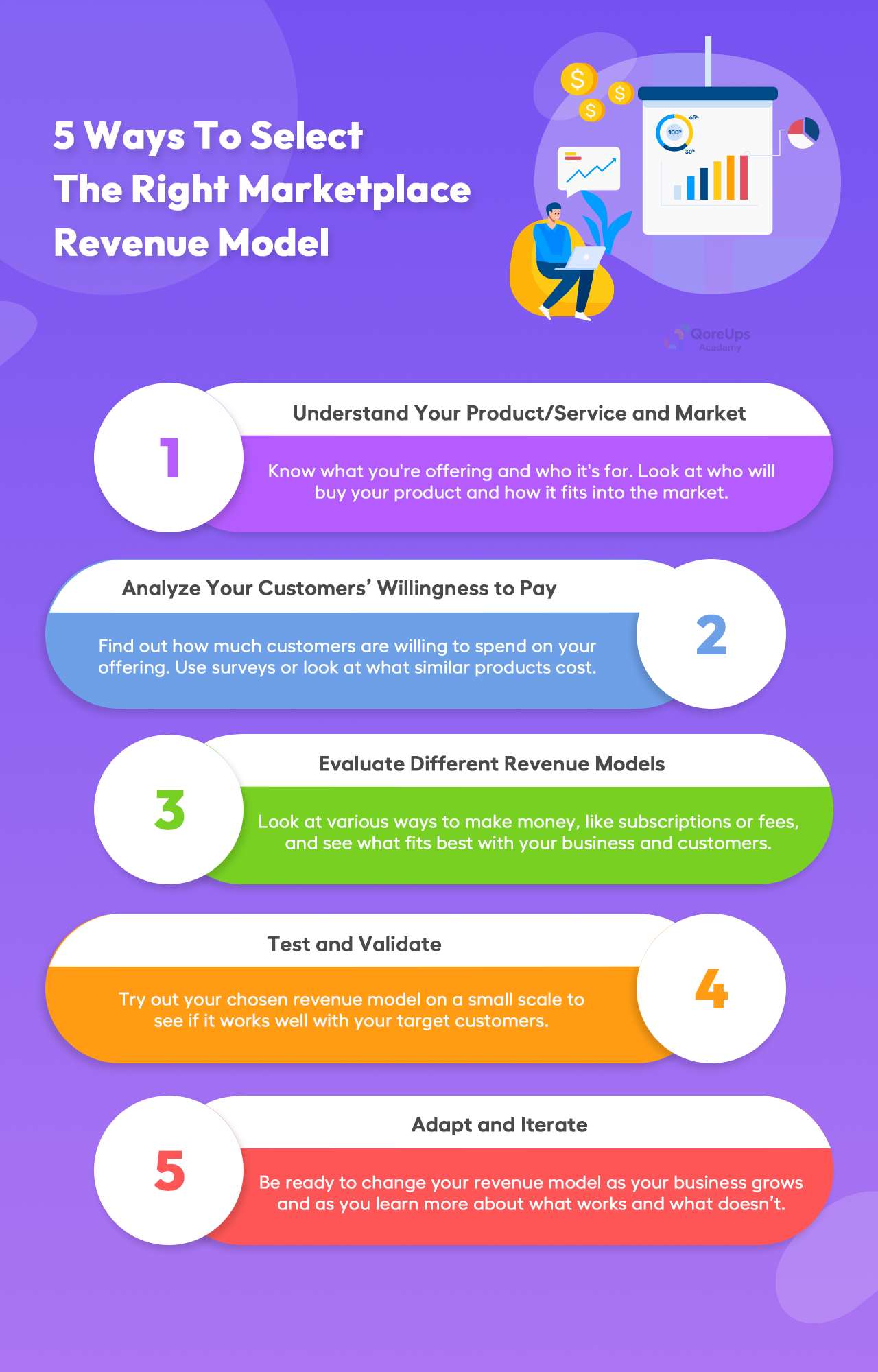Let’s say two strangers are meeting at your house. One of them sells something to another and their deal brings you money.
Though you were barely involved by just letting them meet at your house.
Sounds nice right?
And what if there were hundreds and thousands of them? Wouldn’t it be a great way to earn money as an intermediary?
This is how most marketplaces like Airbnb, Uber, Etsy, Amazon, eBay, etc., make money.
So, there are 5 marketplace revenue models available.
- Commission based model
- Subscription-based model
- Listing fee model
- Freemium model
- Hybrid models
If you are creating an online marketplace, knowing these revenue models is a must. This will help you choose a suitable one for your business. So you can make better profits.

Let’s see them in detail and their real-world applications, as we go deeper into the intricacies of online marketplace monetization.
Each marketplace revenue model brings its own set of challenges and opportunities, shaping the landscape of the digital marketplace in unique ways.
Every model has its own sort of pros and cons. We’ll also analyze them with real-time examples.
Commission Based Model
For example, imagine you’re booking a cozy apartment for your next vacation rental marketplace through Airbnb.
As you confirm your reservation, a small percentage of the total cost is quietly pocketed by Airbnb.
This is what a commission-based marketplace revenue model is.
Whether it’s Airbnb, Uber, or countless others, these platforms thrive by taking a cut of each transaction facilitated on their platform.
Pros
- With every booking or ride, the platform earns a slice of the pie, fostering a direct correlation between usage and revenue.
- The platform’s success hinges on facilitating successful transactions, and aligning its goals with user satisfaction.
Cons
- High commission rates may irk users, especially those on the providing end who feel the pinch of these fees.
- As transaction volumes ebb and flow, so does the platform’s revenue, leaving it exposed to market shifts.
Real World Example: Airbnb
Airbnb’s journey from a humble startup to a global hospitality behemoth is fueled by its commission-based model.
Every time hosts open their homes to guests, a small fraction of the booking fee finds its way into Airbnb’s coffers.
This model has not only made Airbnb immensely profitable but has also empowered millions of individuals worldwide to monetize their spaces, catalyzing the sharing economy’s rise.
Commission Range: As per the Airbnb report, they would charge 14-16% as a commission fee from the host.
Revenue Generated From This Marketplace Revenue Model: $2.2 billion grew 17 percent year-over-year (14% ex-FX). (Reference: Airbnb Q4-2023 and full-year financial results).
Join QoreUps Academy — Get Marketplace Tips and Guidance Sent Directly to Your Inbox!
Subscription-Based Marketplace Revenue Model
Imagine unwinding after a long day with your favorite tunes on Spotify.
You might be on the free tier, tolerating occasional ads, or perhaps you’re a premium subscriber, enjoying uninterrupted playback and a plethora of extra features.
This dichotomy encapsulates the subscription-based marketplace revenue model, where users pay a recurring fee for access to premium content or features.
Pros
- Subscription fees provide a dependable revenue stream, offering stability amidst market uncertainties.
- Different subscription tiers cater to varied user needs, offering flexibility and upselling opportunities.
Cons
- Users may opt-out if they don’t perceive sufficient value, leading to churn and revenue loss.
- Convincing users to subscribe requires finesse, as it’s often more challenging than enticing them with free offerings.
Real World Example: Spotify
Spotify’s melodious ascent to the top of the music streaming industry owes much to its subscription-based model.
While offering a free tier to lure in users, Spotify entices music lovers with premium subscriptions, unlocking a treasure trove of features and ad-free listening.
This approach has not only enriched Spotify’s coffers but has also revolutionized how the world consumes music.
Subscription Range: Starts at $10.99 per month for individuals. (Source: Spotify US)
Revenue Generated From This Marketplace Revenue Model: €3.7 billion which grew 16% from last year. (Reference: Spotify Reports Fourth Quarter 2023 Earnings)
Listing Fee Revenue Model
This marketplace revenue model entails charging sellers a fee to list their products or services on the marketplace.
This model is commonly employed by platforms such as eBay or Etsy, which provide a venue for sellers to showcase their goods to potential buyers.
For instance, eBay imposes a listing fee on sellers for each item listed on the platform, along with optional fees for additional listing features or promotional tools.
Pros
- Buyers can access a diverse range of products without incurring upfront costs.
- The platform earns revenue from listing fees as soon as sellers list their products, ensuring prompt revenue realization.
Cons
- High listing fees may dissuade sellers from listing their products, potentially limiting the assortment of goods available on the platform.
- Given revenue reliance on listing fees, the platform may prioritize quantity over quality, potentially compromising user experience.
Real World Example: eBay
eBay’s listing fee model has been instrumental in fostering a sprawling online marketplace where individuals and businesses can buy and sell an extensive array of products.
Sellers are charged a nominal fee to list their items on eBay, enabling them to reach a global audience of prospective buyers.
Although eBay has faced scrutiny over its fee structure and policies, its listing fee model has proven effective in generating revenue and cultivating a vibrant e-commerce ecosystem.
Listing Fee: Starts at $0.35 to $150 or more per listing. (Source: eBay)
Revenue Generated From This Marketplace Revenue Model: $2.6 billion, a 3% increase from 2022. (Reference: eBay Inc. Reports Fourth Quarter and Full Year 2023 Results)
Freemium Marketplace Revenue Model
The freemium marketplace revenue model offers basic features or services for free, while premium features or additional functionality are available through paid subscriptions.
This model is prevalent in software-as-a-service (SaaS) platforms and social networking sites such as LinkedIn or Dropbox.
Pros
- Free features incentivize user adoption, fueling platform growth and market penetration.
- Premium features present avenues for upselling, enabling the platform to monetize engaged users effectively.
Cons
- Convincing free users to upgrade to premium subscriptions can pose challenges, necessitating robust marketing efforts, and value proposition communication.
- Striking a balance between free and premium features to incentivize upgrades without alienating free users can be intricate and requires meticulous management.
Real World Example: Dropbox
Dropbox, a cloud storage and file-sharing service operates on a Freemium model. It offers basic storage and file-sharing capabilities for free to all users, while additional premium features are available through paid subscriptions.
Free features include a limited amount of storage space (generally around 2GB), file syncing across devices, and basic file-sharing functionality.
Premium features, available through subscription plans such as “Dropbox Plus” or “Dropbox Professional,” provide enhanced functionality and storage capacity.
Premium Fee: Starts at $9.99 to $26. (Source: Dropbox)
Revenue Generated From This Marketplace Revenue Model: $598.8 Million, up 5.9% year-over-year. (Reference: Dropbox Announces Fourth Quarter)
Hybrid Models
Consider Uber, navigating bustling city streets, with drivers and passengers alike reaping the benefits of its hybrid revenue model.
Combining commission-based fees with surge pricing and diversified services, Uber embodies the versatility and resilience of hybrid marketplace revenue models.
Pros
- Hybrid models reduce reliance on a single revenue stream, enhancing resilience against market volatility.
- Multiple revenue streams cater to varied user preferences, broadening the platform’s appeal and market reach.
Cons
- Managing multiple revenue streams entails operational intricacies, necessitating robust infrastructure and managerial oversight.
- Balancing disparate pricing structures and offerings can induce user confusion or dissatisfaction if not communicated effectively.
Real World Example: Uber
Uber combines commission-based fees with surge pricing and diversified services.
Uber’s transformative impact on urban transportation is intricately tied to its hybrid revenue model.
Charging both riders and drivers based on trip metrics, Uber garners revenue with each ride. Surge pricing during peak demand periods balances supply and demand while enticing drivers to hit the road.
Furthermore, ventures like Uber Eats and Uber Freight extend Uber’s reach beyond ride-hailing, diversifying its revenue streams and solidifying its position as a transportation titan.
Hybrid Fee: Uber takes 25% of the fare. (Source: Uber)
Revenue Generated From This Marketplace Revenue Model: $9.9 billion which is 15% YoY. (Reference: Uber Announces Results for Fourth Quarter and Full Year 2023 )
Why Choosing The Right Marketplace Revenue Model Is Important?
Choosing the right way to make money with your marketplace is super important. Here’s why:
First obviously to make money!
- Different ways of making money can affect how much cash your marketplace brings in. Picking the right one means your marketplace can keep running and hopefully grow.
- Each money-making method has its pros and cons. Picking the best one for your marketplace helps you be different from similar sites. That can attract more users and sellers to your marketplace.
Second, to make users happy!
- The way you make money can affect how people feel about your site. If it seems unfair or too expensive, people might not want to use it. But users are more likely to stick around if it’s clear and reasonable.
Third, to make you happy!
- Your money-making plan needs to be able to handle lots of users and transactions. If it can keep up, your marketplace might thrive as it gets more popular.
- Your money-making plan should fit what you want to achieve with your business. Whether you’re aiming to grow fast or make steady profits, your plan needs to support that.
- Markets change, and so do people’s preferences. Your money-making plan should be able to change too, so your marketplace stays popular and successful.
- If you’re looking for investors to help you out, your money-making plan needs to look good to them. They want to see that your marketplace can make them money too.
In short, picking the right way to make money with your marketplace is a big deal.
It affects how much money you make, how you compare to others, how happy your users are, how big you can grow, whether you reach your goals, and whether investors want to get involved.
So, it’s worth taking the time to get it right!
5 Ways To Selecting The Right Marketplace Revenue Model
Selecting the right marketplace revenue model is a critical decision for any business. It shapes how you generate income, interact with customers, and grow your company.

Understand Your Product/Service And Market
Begin by deeply understanding what you offer and who it’s for.
Analyze your product or service’s value proposition, how it solves a problem or fulfills a need, and who your target customers are.
Consider the broader market dynamics, including competition, customer purchasing behavior, and industry trends.
This foundational understanding will help you identify which marketplace revenue models align with your offerings and market expectations.
Analyze Your Customers’ Willingness To Pay
Research to understand your potential customers’ willingness to pay for your product or service.
This involves exploring how much value your target customers place on the solutions you offer and their preferred methods of payment.
Surveys, focus groups, and analysis of competitor pricing can provide insights into your customers’ price sensitivity and payment preferences.
Join QoreUps Academy — Get Marketplace Tips and Guidance Sent Directly to Your Inbox!
Evaluate Different Marketplace Revenue Models
With a good grasp of your market and customers’ willingness to pay, examine various marketplace revenue models.
Look at models such as subscription, commission, freemium, listing fee, and hybrid models.
Consider the pros and cons of each model in the context of your business.
For instance, subscription models may provide steady revenue but require high customer retention efforts, while commission models can scale well but might reduce control over customer experience.
Test And Validate
Once you’ve narrowed down your options, test the viability of the chosen marketplace revenue models.
This could involve creating minimal viable products (MVPs), running pilot programs, or setting up experiments to gauge customer response and payment behavior.
Testing helps validate assumptions about customer willingness to pay and the operational feasibility of implementing your chosen marketplace revenue model.
Adapt And Iterate
The selection of a revenue model is not a one-time decision.
As your business grows and market conditions change, be prepared to adapt and possibly pivot your marketplace revenue model.
Continuously gather feedback from your customers and analyze financial performance data to understand what’s working and what isn’t.
Being flexible and willing to adjust your approach is key to finding the most effective marketplace revenue model over time.
By following these steps, you can more effectively determine the marketplace revenue model that aligns with your business goals, market position, and customer expectations, setting a solid foundation for growth and profitability.
Which Is The Best Marketplace Revenue Model?
So far now, you have seen the five best revenue models for the marketplace. Well, each model has its own pros and cons.
Definitely, not every revenue model suits every marketplace.
Ensure the marketplace revenue model you select is appropriate for your industry, your target market, the number of items you want to deal with, and your revenue goals.
You can utilize many marketplace revenue models separately or in combination with other strategies.
If you are a baby marketplace owner, you can start your marketplace revenue model as a commission.
You can implement one marketplace revenue model at the beginning. Later you can change it to a different revenue model by considering the marketplace and personal interests.
Once you’ve chosen the revenue model, start creating an online marketplace with the marketplace builder!






